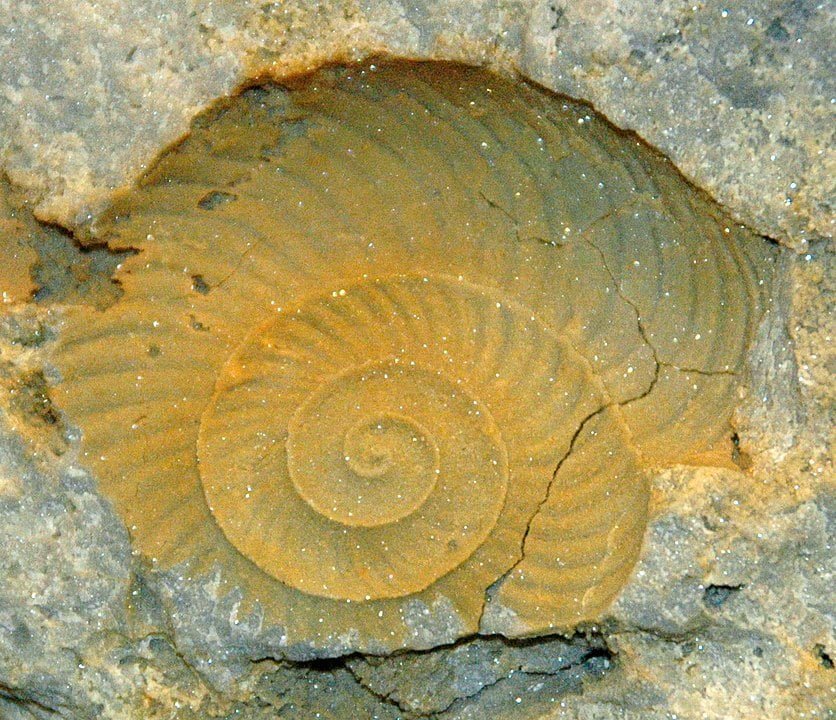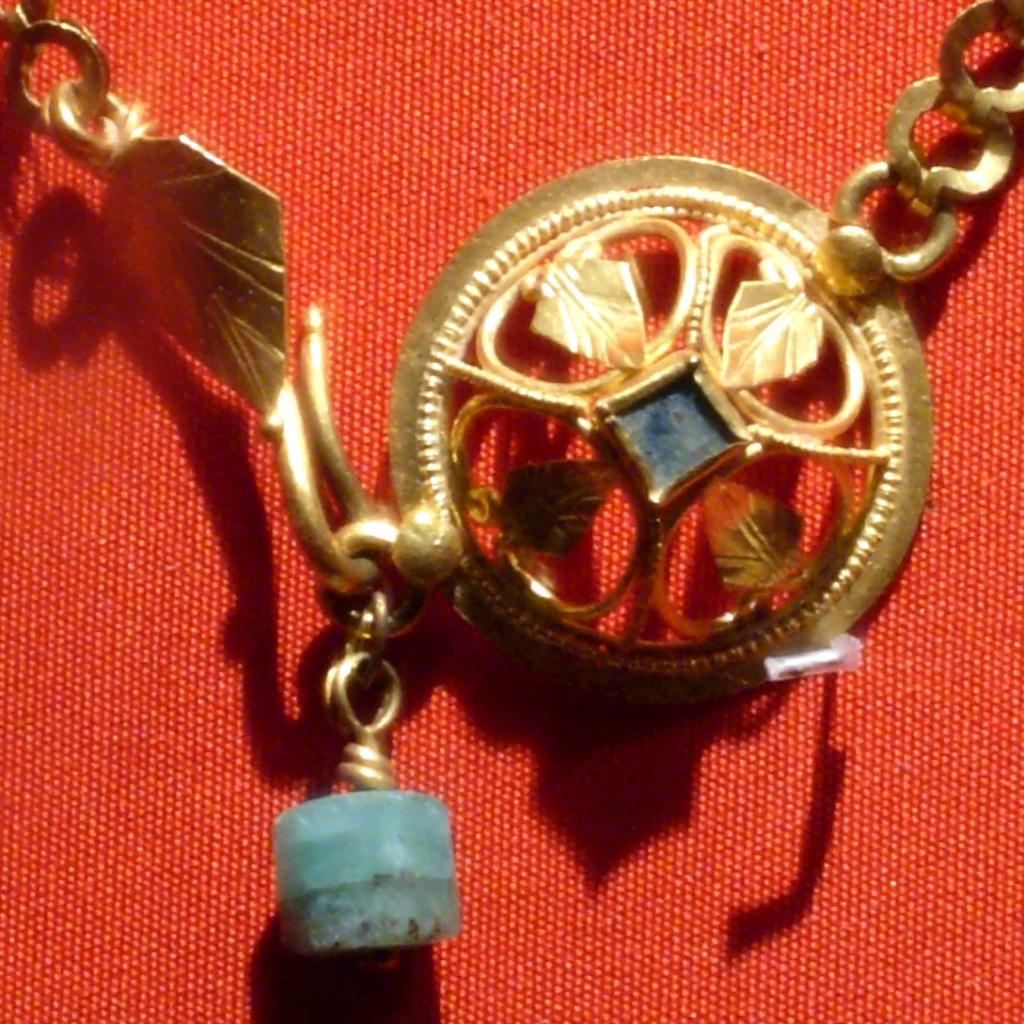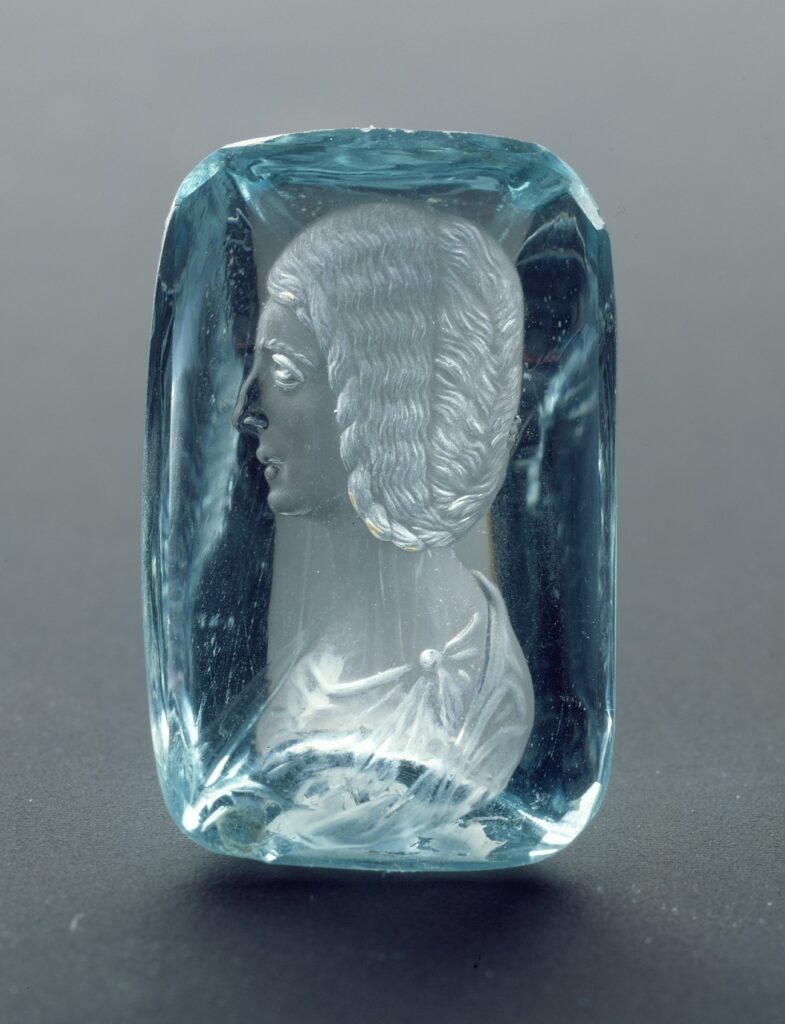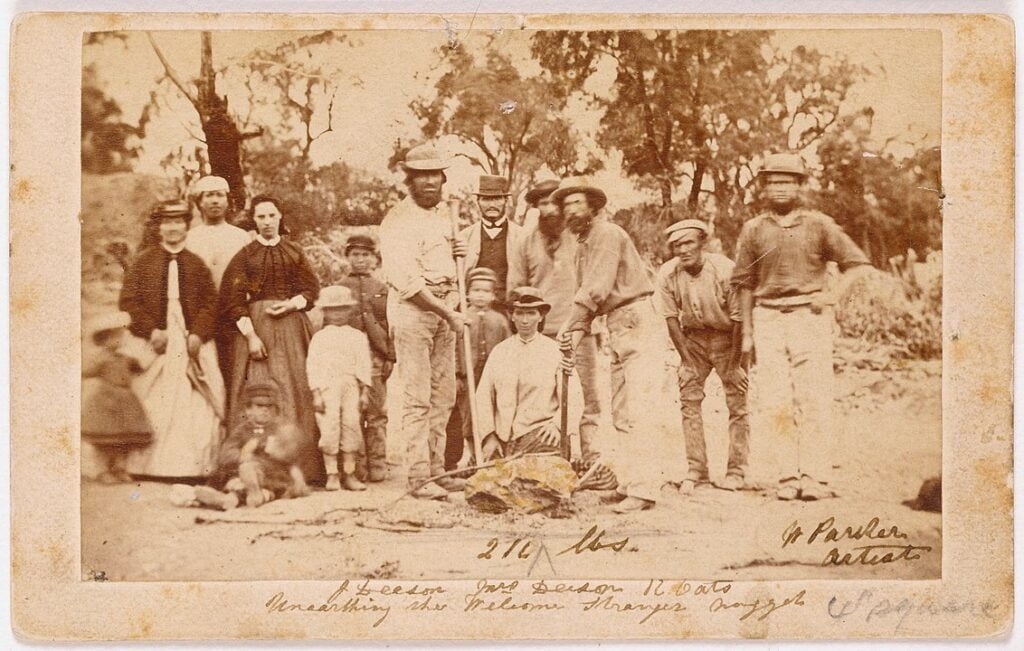
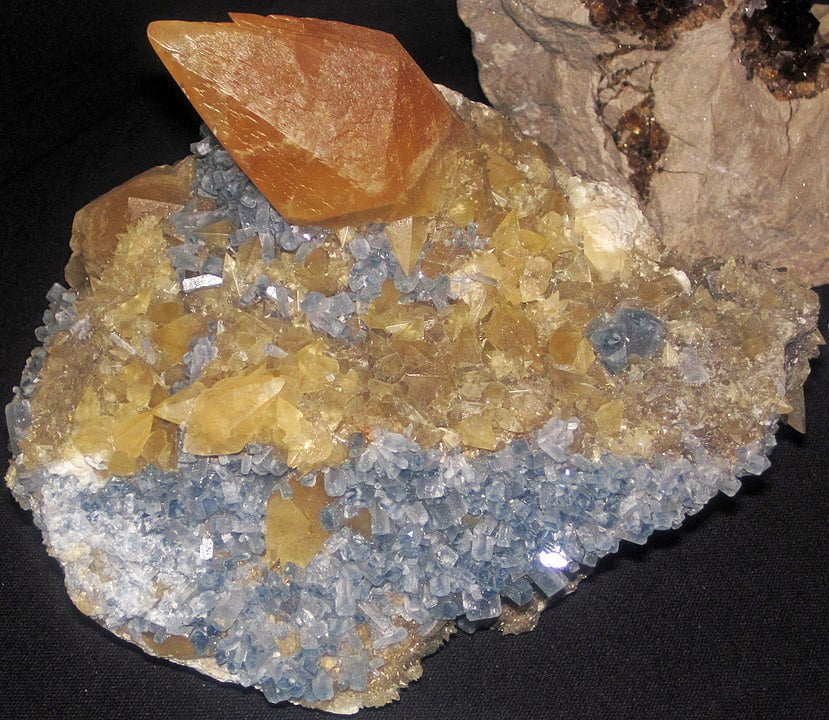
Calcite and celestite crystals from Ohio
If you live in Ohio and want to get rich finding Emeralds then forget it. Your best bet for that is to move to the Asheville, NC. Our state just doesn’t have the Geology necessary for that sort of gemstone to be present. It’s true people do find gold and diamonds (six of those have been found in Ohio, not including those found in jewelry stores) in Ohio, but those are travelers that arrived courtesy of glaciers and deposited in glacial sedimentary deposits.
But just because you can’t fill a jewelry shop from our geology doesn’t mean that Ohio isn’t rich in crystal treasure. Our state is blessed with minerals that are used industrially and helped turn the state into an Industrial powerhouse. It also is a source of beautiful minerals perfect for a collection or as a display piece (Celestite, I am looking at you!) And don’t get me started talking about fossils! Cincinnati is famous for its rich troves of Ordovician era fossils on the Cincinnati Arch. You know where to go if you want a Trilobite.
Since most locals aren’t aware of our state’s Geology, let alone that we have a geology, or if we have one, where somebody may have misplaced it, how much it’s worth and whether you can trade it to rent Top Gun: Maverick on Amazon, we are presenting a curated list of the crystals and minerals found in the Buckeye state.
Photo credit for image above: Photo By James St. John – https://www.flickr.com/photos/47445767@N05/33229612163/, CC BY 2.0, https://commons.wikimedia.org/w/index.php?curid=96284794
Calcite
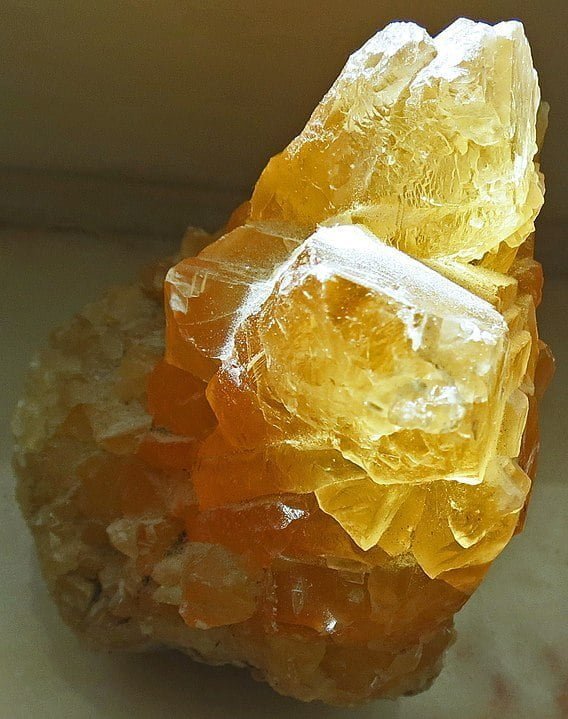
Sunlit Silurian calcite from Put-in-Bay in Ohio on Lake Erie.
Photo By James St. John – https://www.flickr.com/photos/47445767@N05/50588186197/, CC BY 2.0, https://commons.wikimedia.org/w/index.php?curid=96284996
Calcite is found throughout Ohio in different forms as granular aggregates in black shale in eastern and central Ohio, and as crystal and granular aggregates in Western Ohio.
The name calcite comes from a Greek word meaning lime. This comes from its chemical component, Calcium Carbonate, which sometimes is mistakenly known as “lime.” Calcite is known in more than 300 forms of crystals. The scalenohedral crystals of Calcite, one of its most common varieties, ordinarily are known as “dogtooth spar” or “dogtooth calcite” because of their resemblance to a dog’s canine tooth. Another variety, transparent rhombohedral calcite, is used in optical equipment. Although they are not specific varieties of calcite, stalactites, stalagmites and other formations found in caverns are made of calcite.
Calcite is one of the most common minerals, making up about 4% by weight of the Earth’s crust. Calcite is common as vein fillings in many rocks in western and central Ohio. Silurian dolomites in northwestern Ohio yield clusters of large crystals ranging from clear to dark brown. Many have a golden color.
Crystals and granular aggregates in cavities and fractures of dolostones and limestones in western Ohio; granular aggregates commonly form veins in dolostone concretions and less commonly in ironstone concretions from black shales in central and eastern Ohio; more rare as an efflorescence.
Calcite (CaCO3) is a soft carbonate mineral that occurs in various colors, including white, yellow, brown, gray, black, and pink, and also can be colorless. Calcite is a common mineral that occurs primarily in limestone and dolostone, occasionally in concretions and rarely as an efflorescence.
The Romans made concrete by mixing lime and volcanic ash to create a pozzolanic reaction. If this was mixed with volcanic tuff and placed under seawater, the seawater hydrated the lime in an exothermic reaction that solidified the mixture.
Aragonite
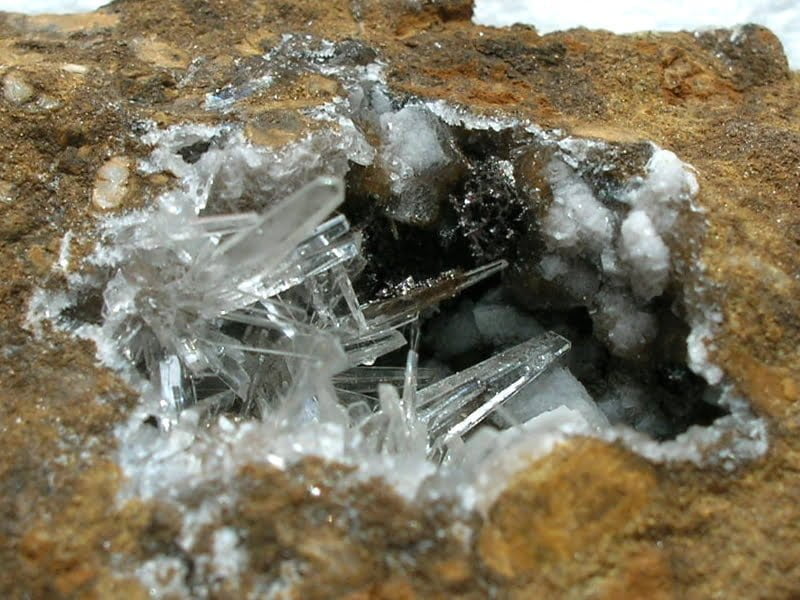
Vug with aragonite crystals in arenaceous, ferruginous, fossiliferous limestone from Ohio
Photo By James St. John – Vug with aragonite crystals in arenaceous, ferruginous, fossiliferous limestone (Vinton Member, Logan Formation, Lower Mississippian; Mt. Calvary Cemetery Outcrop – Rt. 13 roadcut, Heath, east-central Ohio, USA) 3, CC BY 2.0, https://commons.wikimedia.org/w/index.php?curid=82971990
With a name that sounds like a heroic character in J.R.R. Tolkien’s The Lord of the Rings, but originates from the territory of Aragon in Spain, aragonite is one of the three most common forms of calcium carbonate. Its crystal lattice differs from calcite, one of the other common forms of calcium carbonate. It has a host of industrial uses. Aragonite has been found in Coshocton County.
Celestite

Crystal Cave is a small cave in Put-in-Bay on Lake Erie in Ohio touted as the world’s largest geode. An abundance of large, well-formed crystals of celestite cover the walls. The cave was originally mined for its strontium content, but enough nice crystals still remain to keep the site open as a show cave.
Photo by James St. John – Celestite (Crystal Cave, South Bass Island, Lake Erie, Ohio, USA) 16, CC BY 2.0, https://commons.wikimedia.org/w/index.php?curid=82969277
A soft sulfate mineral ore of strontium, in fact being the most common mineral that contains strontium. Celestite derived strontium is used industrially in fireworks, ceramic magnets, and toothpaste
Ohio is famous for having some of the best celestite deposits in the world. The mineral is found in 11 counties. The northwestern regions of Ohio amid the Findlay Arch produce celestite ranging in color from white to pale blue. The area of Serpent Mound southwestern Ohio also produces some celestite due to an unusual geological occurrence. South Bass Island is a huge vug filled with very large celestite crystals.
Quartz
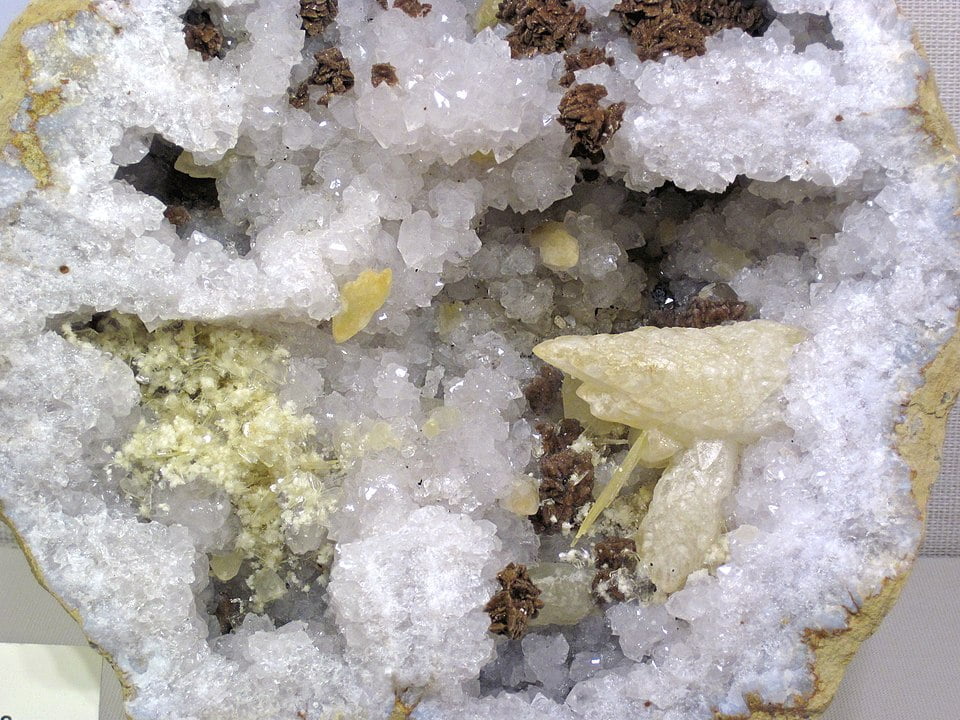
Close-up of a Monroe County, Ohio geode with sphalerite, barite, dolomite and quartz.
Photo by James St. John – Geode with sphalerite, barite, dolomite, and quartz (Monroe County, Ohio, USA) 2, CC BY 2.0, https://commons.wikimedia.org/w/index.php?curid=84692026
What can’t you not say about quartz? It is a hard silicate in the form of silicon dioxide. It’s useful in glassmaking, watchmaking, ceramics, metal casting, electronics, and the petroleum industry. But the enduring love it receives is because of it’s beauty and variety: rose quartz, lavender quartz, blue quartz, rutilated quartz, citrine, amethyst, enhydro quartz, prasiolite, ametrine and a variety of shapes including points, needles, and clusters.
In Ohio, quartz is found in flint beds in Coshocton, Licking, and Muskingum Counties; in Adams and Highland Counties; in septarian limestone concretions in the central portion of the state; and loose in streambeds and creeks in the Southeast.
Fluorite

An example of Ohio Fluorite from Stoneco Auglaize quarry (Maumee Stone County quarry), Junction, Paulding County, Ohio.
A 1.2 cm colorless cube with well-centered, distinct, rich purple color “phantom” inside. The crystal has very sharp faces and excellent gemminess. It sits upon a small amount of Dolostone matrix
Photo by Rob Lavinsky, iRocks.com – CC-BY-SA-3.0, CC BY-SA 3.0, https://commons.wikimedia.org/w/index.php?curid=10148353
Fluorite is a another name for calcium fluoride, a halide ore mineral of fluorine. It’s has several industrials uses including as a flux for removing impurities in the manufacture of steel and in the production of fluorine gas which itself is used in the refining of uranium.
While fluorite is found across the world, the quality and largest quantities are mined out of Europe and North America. In Ohio fluorite is found in 19 counties. Typically cubic crystals found in dolostones in northwestern Ohio particularly along the edges of the Findlay Arch and occasionally in the Serpent Mound area.
Some fluorite is UV reactive, fluorescing under exposure. Because of this property, it and it’s compounds are used to manufacture synthetic crystals with applications in laser and special UV and infrared optics.
Dolomite
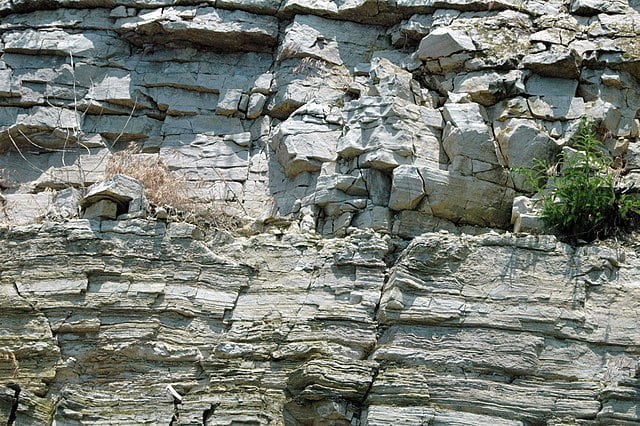
Ohio Dolostone. In the past Dolomite was used to refer to both the mineral and the rock. Dolomite is now used to refer to the mineral and dolostone refers to sedimentary rock whose primary content is dolomite.
Photo By James St. John – Put-in-Bay Dolomite over Tymochtee Dolomite (Upper Silurian; South Bass Island, Lake Erie, Ohio, USA) 6, CC BY 2.0, https://commons.wikimedia.org/w/index.php?curid=82969360
What relationship does Ohio have with a nineteenth century french geologist? The answer in one word is Dolomite! Named after Déodat Gratet de Dolomieu, Dolomite is found in over 19 Ohio counties. Dolomite differs from limestone in that it contains both calcium and magnesium.
More well known as an Indiana mineral, especially the Corydon area, this calcium magnesium carbonate occurs in small crystals in western Ohio and along the Huron river among other areas.
Dolomite has industrial uses including as a source of magnesium salts like magnesia and by builders as structural and ornamental stone.
The term dolomite used to refer both to the mineral dolomite and dolostone (a sedimentary rock of which is made primarily of dolomite).
Barite
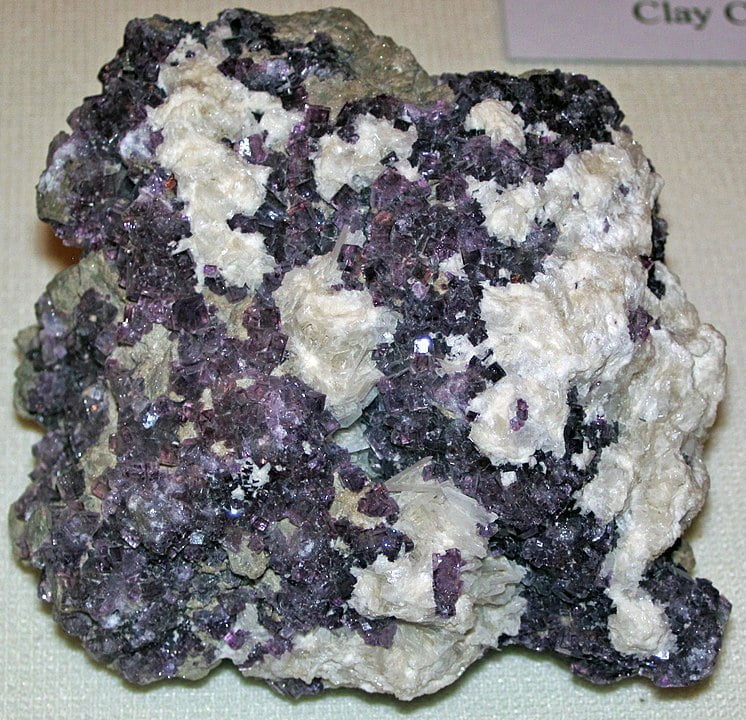
Fluorite and barite from Marblehead Peninsula Ohio
Photo By James St. John – Fluorite and barite (quarry in Marblehead Peninsula, far-northern Ohio, USA), CC BY 2.0, https://commons.wikimedia.org/w/index.php?curid=40022633
Found in over 26 counties in Ohio, this Barium Sulfate mineral often associated with calcite and other minerals is often white or colorless but can also have light blues, greys, yellows or browns. In the central and eastern Ohio black shale formations barite is found in concretions such as limestone, ironstone and pyrite. In the northwestern and southwestern Ohio crystalline or granular barite can be found in fractures and cavitiesof dolostones (dolomite sedimentary rock).
Barite is the primary ore for barium, and has varied industrial uses including paper, paint and glass manufacture as well medical radiology (as a dye) and in oil drilling.
Barites crystals found in Ohio can sometimes be massive in size.
Malachite
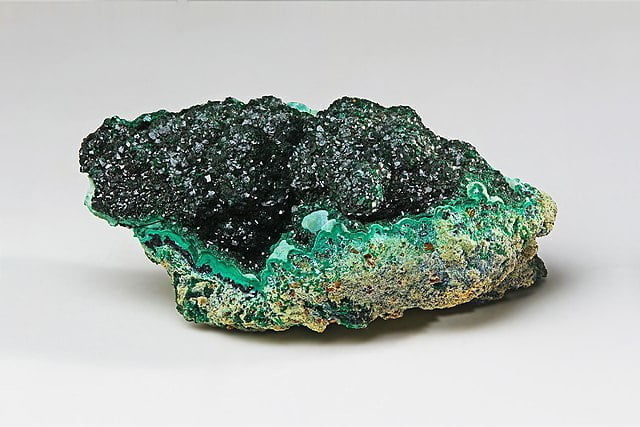
Malachite – sadly from Zaire and not Ohio
Photo By JJ Harrison (https://www.jjharrison.com.au/) – Own work, CC BY-SA 3.0,https://commons.wikimedia.org/w/index.php?curid=7515677
Typically found in botryoidal, stalagmitic, or fibrous masses, beautiful green malachite is collectible, and displayable.
It was a little hard to believe that malachite is found in Ohio, but according to the state it actually is present. Since it’s a copper carbonate hydroxide mineral it obviously needs copper to be present to form, and I did find a reference to a copper mine in Cuyahoga county.
Pyrite
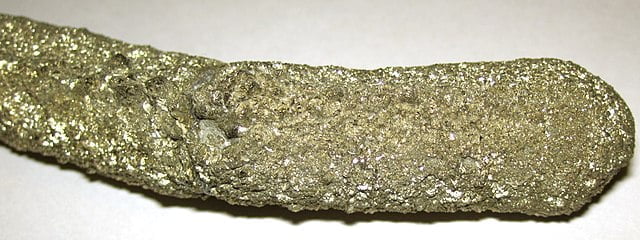
Pyrite
Photo By James St. John – Pyrite snake concretion (Ohio Shale, Upper Devonian; creek cut in Ross County, southern Ohio, USA) 8, CC BY 2.0, https://commons.wikimedia.org/w/index.php?curid=84692435
Iron Pyrite, commonly known as “fool’s gold”, is metallic iron sulfide mineral found in over 88 Ohio counties, typically in Devonian or Pennsylvanian shales. Pyrite has been used as an ore for sulfur and a source of iron.
The most common sulfide mineral, pyrite can form form in extremely well-crystallized examples of cubes, pyritohedrons, and octahedrons.
Sphalerite
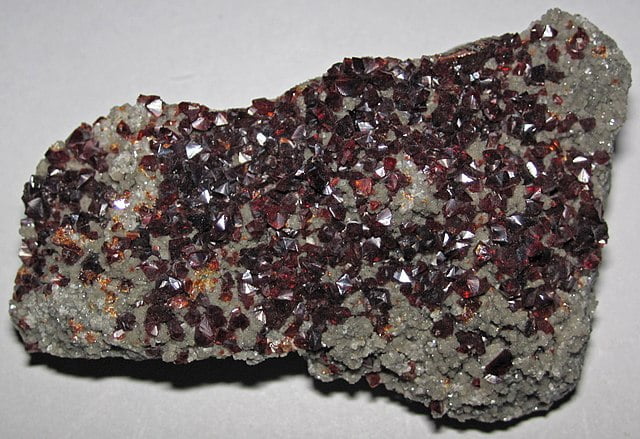
Sphalerite crystals atop sucrosic dolostone from Sandusky County, Ohio
Photo by James St. John – https://www.flickr.com/photos/jsjgeology/31282767801/, CC BY 2.0, https://commons.wikimedia.org/w/index.php?curid=101721070
Sphalerite is a sulfide mineral that is an ore of zinc, cadmium, gallium, germanium, and indium. It has a wide variety of colors including light/dark brown, red-brown, yellow, red, green, light blue, black, and colorless. It occurs in the Findlay Arch area, near Serpent Mound, and in Eastern Ohio.
Smithsonite
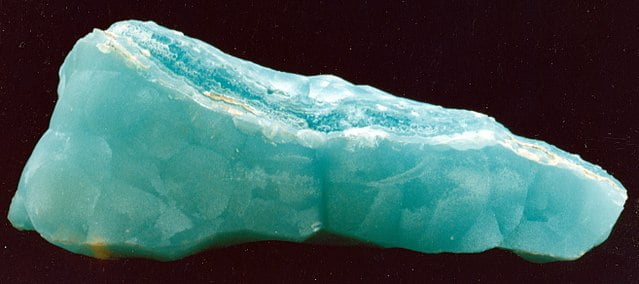
Illustrative example of smithsonite – sadly, not from Ohio. This example is from the Kelley Mine in Soccorro County, New Mexico.
Photo by Bureau of Mines – http://libraryphoto.cr.usgs.gov/cgi-bin/show_picture.cgi?ID=ID.%20BOM%20Mineral%20Specimens%20016, Public Domain, https://commons.wikimedia.org/w/index.php?curid=1825549
Smithsonite is named after English geologist and chemist James Smithson. Also known as zinc spar, this form of mineral zinc carbonate is a variably colored trigonal mineral.
Special Mention: Fossils
While not minerals, it would be unforgivable to not mention Ohio’s rich treasure trove of minerals. The greater Cincinnati area (which includes parts of northern Kentucky and southeastern Indiana) sits atop what is known as the Cincinnati Arch, the eroded remains of a mountain range from Michigan to Alabama that was thrust up by collision of two ancient continents. The arch sank beneath a series of shallow inland seas filled with marine life ending up as deposits of fossils in what is known to geologists as the Cincinnatian Epoch.
The region is famous for a wide variety of marine fossils, but particularly Trilobites, a now extinct member of the arthropod family.
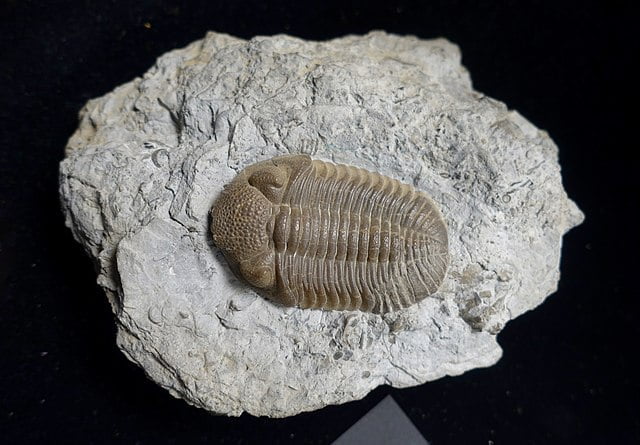
Example of Ohio Eldredgeops rana fossil
Photo by Daderot – Own work, CC0, https://commons.wikimedia.org/w/index.php?curid=83993913
Graftonoceras – limonite-stained external mold of nautiloid in dolostone
Photo By James St. John – Graftonoceras fossil nautiloid (Lockport Dolomite, Middle Silurian; Coldwater, southern Mercer County, western Ohio, USA), CC BY 2.0, https://commons.wikimedia.org/w/index.php?curid=36833417
